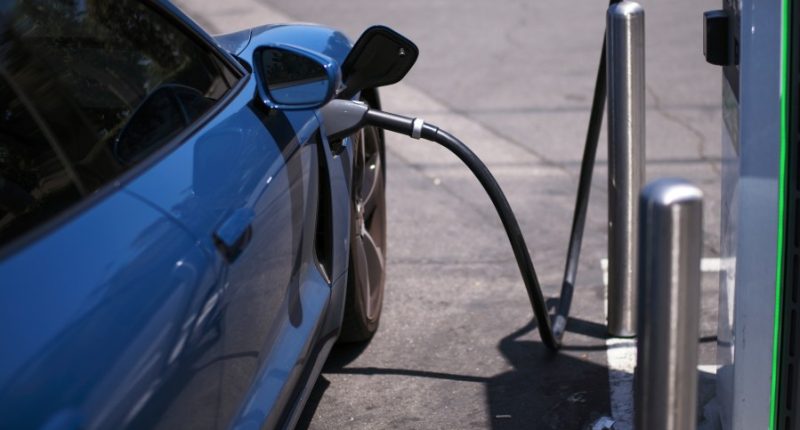Share this @internewscast.com

The massive tax and spending cut bill that Congress passed Thursday ends federal tax incentives for electric vehicles.
Consumers have until September 30 to take advantage of the federal tax credits for electric vehicles (EVs) before these incentives come to an end. Nonetheless, experts suggest that there are compelling financial reasons to consider purchasing EVs even without these benefits.
Previously, new electric vehicle buyers benefited from a $7,500 federal tax credit, while purchasers of used EVs could receive up to $4,000. These financial incentives aimed to make EVs more accessible financially. Data from Kelley Blue Book reveals that on average, a new electric vehicle costs around $9,000 more in the U.S. than a new gasoline vehicle, and used EVs carry a price tag roughly $2,000 higher than their gas-powered counterparts.
These tax credits, combined with various state incentives, played a crucial role in reducing the cost disparity. Without these benefits, Ingrid Malmgren, Senior Policy Director at the nonprofit Plug In America, noted that EVs might become too costly for many Americans with lower or middle incomes.
“That’s really disappointing because … they’re just a really great way to reduce transportation energy cost burden,” Malmgren said.
The up-front cost of an electric vehicle might be higher, but for those who can afford to consider the lifetime fuel and maintenance savings, Malmgren said the EV is still a good financial and environmental move in every state.
EVs are typically still cheaper to own long-term
That is because electric vehicles might not be cheaper to buy, but they are cheaper to drive. Malmgren said that even without the federal tax credits, an electric vehicle owner would still come out ahead.
“Quickly you’ll end up paying less than a gas car because it costs much less to fuel, and it needs almost nothing for maintenance,” Malmgren said.
Malmgren said the point at which an EV driver’s savings on fuel and maintenance outweigh the higher initial price varies. It depends on the kind of car and how often they are driven, as well as the cost of gasoline and electricity in an area. She said EV owners pay less in upkeep because the cars typically have fewer moving parts to maintain and require less frequent servicing. There are multiplecalculators online that pinpoint that moment based on some of those criteria.
A 2020 study in the academic journal Joule found that the average EV in the U.S. charged with a typical mix of public and private chargers saves the driver $7,700 in fuel costs over a 15-year life span, compared to filling a car with gas. Savings vary by state. The study found that someone charging a car at home during off-peak hours, deemed as a best-case scenario, could save more than $14,000 over 15 years in Washington, where electricity is relatively affordable. The study said that an EV driver in any state exhibiting typical driving and charging behavior would save money on fuel costs. The study did not account for the car’s purchase price, its maintenance cost or associated tax credits.
EVs are still cleaner, even when they charge on coal power
Manufacturing an electric vehicle typically creates more pollution than making a traditional gas-powered one. But experts say that driving an EV over the long-term is still less polluting than a gas car.
Once they both drive about 15,000 miles (24,000 km) — slightly more than the average American drives in a year — the total pollution that has gone into making and driving each type of car has evened out, said Peter Slowik, U.S. Passenger Vehicles Lead for the International Council on Clean Transportation. Every mile after that widens the gap between the cleaner electric car and the more pollutive gas car. By the end of the car’s life, emissions caused by the average EV are roughly half the average gas car, according to the U.S. Department of Energy.
So unless you buy a new car each year, the EV is the cleaner choice, he said.
“They are a no-brainer,” Slowik said. “Electric vehicles are already inherently so much more efficient.”
A 2023 analysis by Yale Climate Connections found that electric vehicles are responsible for less carbon dioxide pollution even in areas where the electricity used to charge them comes from coal. An EV in West Virginia, which is one of the most coal-reliant states, still pollutes 31% less than an equivalent gas-powered car, according to the analysis.
Slowik said that is because electric cars are better at translating energy into forward motion. For example, the most popular EVs in the US, the Tesla Model Y and the Tesla Model 3, can drive more than 100 miles (161 km) on energy equivalent to what is provided by a gallon of gasoline.
“If you compare that to a 25-mpg gasoline vehicle, that’s already four to five times more efficient,” Slowik said.
___
The Associated Press’ climate and environmental coverage receives financial support from multiple private foundations. AP is solely responsible for all content. Find AP’s standards for working with philanthropies, a list of supporters and funded coverage areas at AP.org.

















